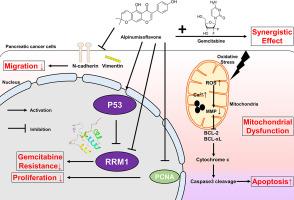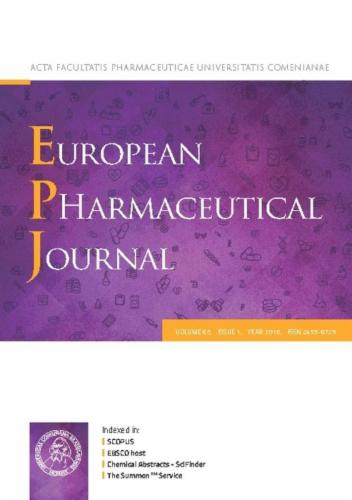In vitro and in silico study of the synergistic anticancer effect of alpinumisoflavone with gemcitabine on pancreatic ductal adenocarcinoma through suppression of ribonucleotide reductase subunit-M1
IF 4.3
3区 医学
Q1 PHARMACOLOGY & PHARMACY
引用次数: 0
Abstract
A highly aggressive neoplastic disease, pancreatic ductal adenocarcinoma (PDAC) is documented as the third chief cause of cancer-associated mortality in both sexes combined in the United States. For decades, gemcitabine-based chemotherapy has been embraced as a cornerstone drug for the treatment of PDAC. However, there have been several unsolved problems, including cytotoxicity, and chemoresistance. Gemcitabine efficacy was attributed to the attenuation of ribonucleotide reductase subunit-M1 (RRM1). Overexpression of RRM1 in PDAC is highly correlated with gemcitabine resistance and reduced gemcitabine sensitivity, resulting in a poor survival rate even after gemcitabine treatment. Moreover, the status of TP53, a tumor suppressor gene, assumes a decisive role in the response of PDAC to gemcitabine. Therefore, targeting RRM1 and P53 might be a therapeutic strategy for strengthening gemcitabine efficacy and cytotoxicity against PDAC. Alpinumisoflavone (AIF) is a prenylated isoflavone originated in Cudrania tricuspidate with versatile bioactive properties, including anticancer activity. However, there was no report whether AIF can exert anticancer effect and exhibit synergistic effect with gemcitabine against PDAC. Therefore, the anticancer properties of AIF were assessed with PANC-1 and MIA PaCa-2. In addition, synergism between AIF and gemcitabine were analyzed. Moreover, the contribution of P53 and RRM1 expression to gemcitabine resistance was assessed by comparing their protein levels in PDAC cells and normal pancreatic cells. The interactions of AIF with RRM1 protein were confirmed by molecular docking and dynamics simulation. Therefore, AIF enhances gemcitabine efficacy against PDAC through the regulation of P53 and RRM1.

通过抑制核糖核苷酸还原酶亚基-M1对胰腺导管腺癌的协同抗癌作用的体外和硅学研究。
胰腺导管腺癌(PDAC)是一种侵袭性极强的肿瘤性疾病,在美国,它是导致男女癌症相关死亡率的第三大主要原因。几十年来,以吉西他滨为基础的化疗一直是治疗 PDAC 的基石药物。然而,吉西他滨也存在一些尚未解决的问题,包括细胞毒性和化疗耐药性。吉西他滨的疗效归因于核糖核苷酸还原酶亚基-M1(RRM1)的衰减。RRM1 在 PDAC 中的过表达与吉西他滨耐药和吉西他滨敏感性降低高度相关,导致吉西他滨治疗后的存活率仍很低。此外,抑癌基因 TP53 的状态在 PDAC 对吉西他滨的反应中起着决定性作用。因此,靶向 RRM1 和 P53 可能是加强吉西他滨对 PDAC 的疗效和细胞毒性的一种治疗策略。Alpinumisoflavone(AIF)是一种源于三尖杉的前烯化异黄酮,具有多种生物活性,包括抗癌活性。然而,AIF 能否发挥抗癌作用,并与吉西他滨对 PDAC 产生协同效应,目前尚无报道。因此,我们用 PANC-1 和 MIA PaCa-2 评估了 AIF 的抗癌特性。此外,还分析了 AIF 与吉西他滨之间的协同作用。此外,通过比较 P53 和 RRM1 在 PDAC 细胞和正常胰腺细胞中的蛋白水平,评估了 P53 和 RRM1 的表达对吉西他滨耐药性的贡献。分子对接和动力学模拟证实了AIF与RRM1蛋白的相互作用。因此,AIF通过调控P53和RRM1增强了吉西他滨对PDAC的疗效。
本文章由计算机程序翻译,如有差异,请以英文原文为准。
求助全文
约1分钟内获得全文
求助全文
来源期刊
CiteScore
9.60
自引率
2.20%
发文量
248
审稿时长
50 days
期刊介绍:
The journal publishes research articles, review articles and scientific commentaries on all aspects of the pharmaceutical sciences with emphasis on conceptual novelty and scientific quality. The Editors welcome articles in this multidisciplinary field, with a focus on topics relevant for drug discovery and development.
More specifically, the Journal publishes reports on medicinal chemistry, pharmacology, drug absorption and metabolism, pharmacokinetics and pharmacodynamics, pharmaceutical and biomedical analysis, drug delivery (including gene delivery), drug targeting, pharmaceutical technology, pharmaceutical biotechnology and clinical drug evaluation. The journal will typically not give priority to manuscripts focusing primarily on organic synthesis, natural products, adaptation of analytical approaches, or discussions pertaining to drug policy making.
Scientific commentaries and review articles are generally by invitation only or by consent of the Editors. Proceedings of scientific meetings may be published as special issues or supplements to the Journal.

 求助内容:
求助内容: 应助结果提醒方式:
应助结果提醒方式:


